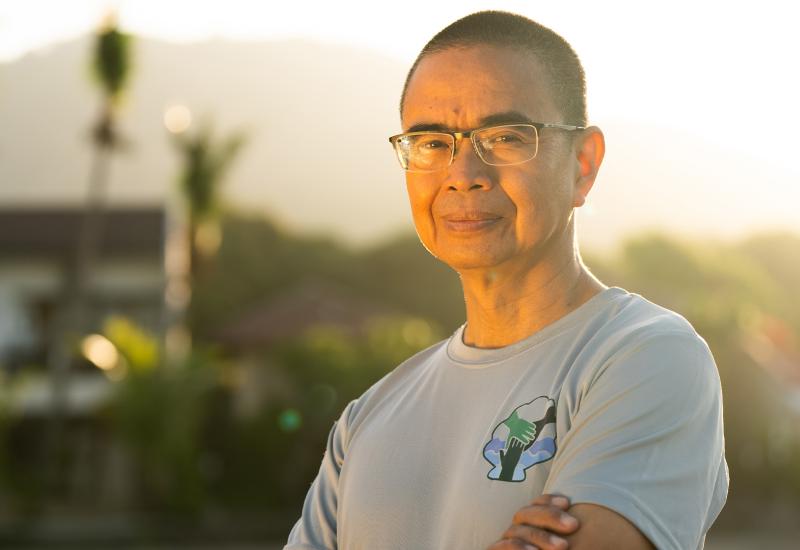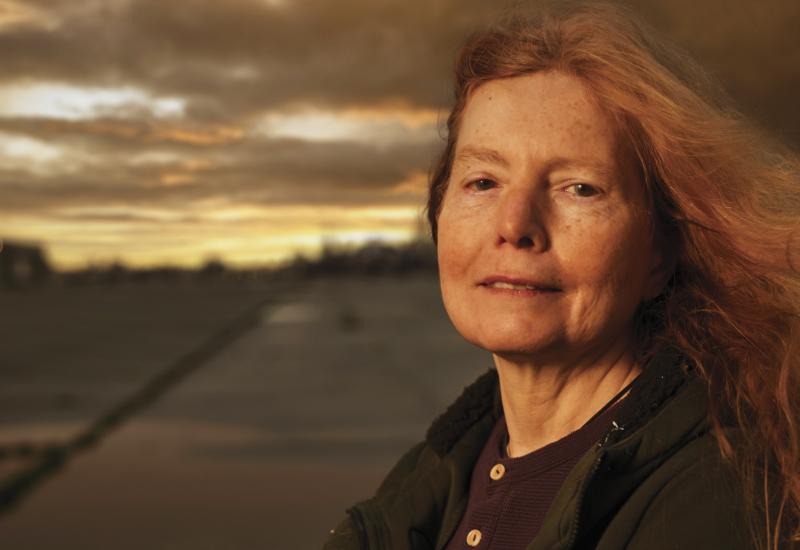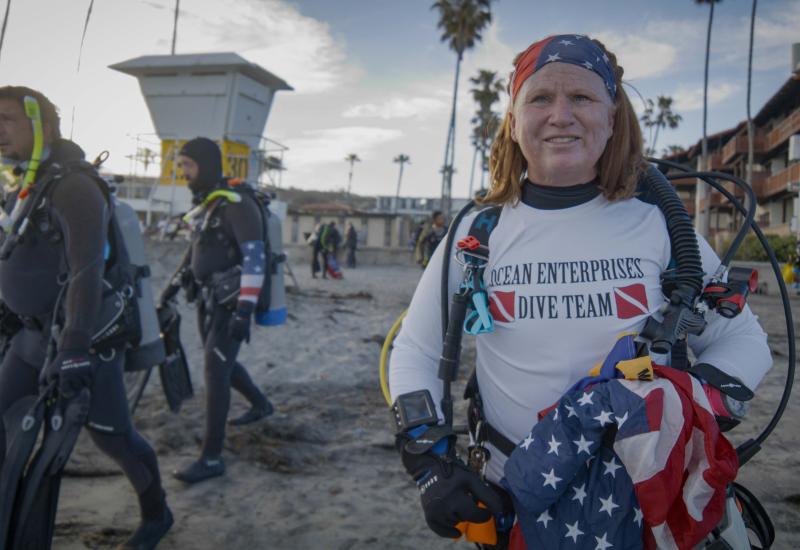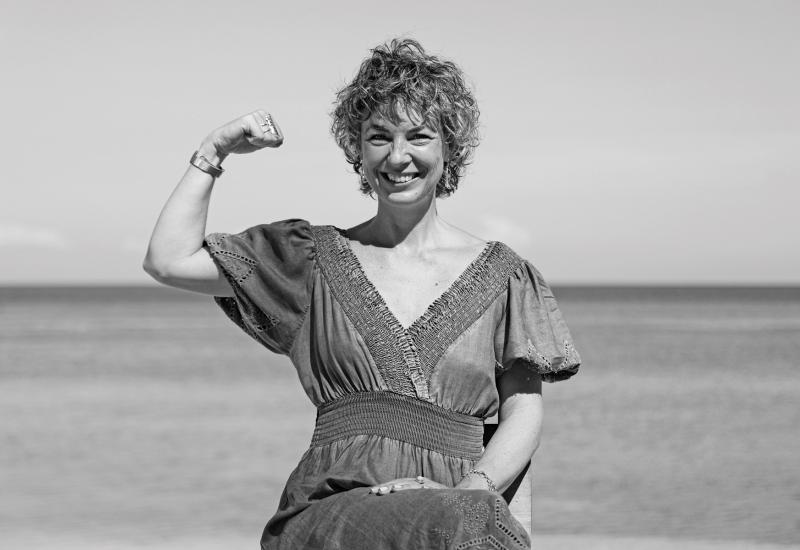Author and Underwater Photographer Suzan Meldonian Named Sea Hero
YEAR DIVE CERTIFIED: 1975
AGE WHEN CERTIFIED: 20
DIVE CERTIFICATION LEVEL: PADI Rescue Diver
WORDS TO LIVE BY: "If all you see when you look at the sea is nothing more than a mere blue horizon line, while you may find solace is its expanse, you have no idea of the complexity of the life cycles that abound and flourish below. Perhaps there is something to be witnessed, something to be learned, by us, their neighbors above."
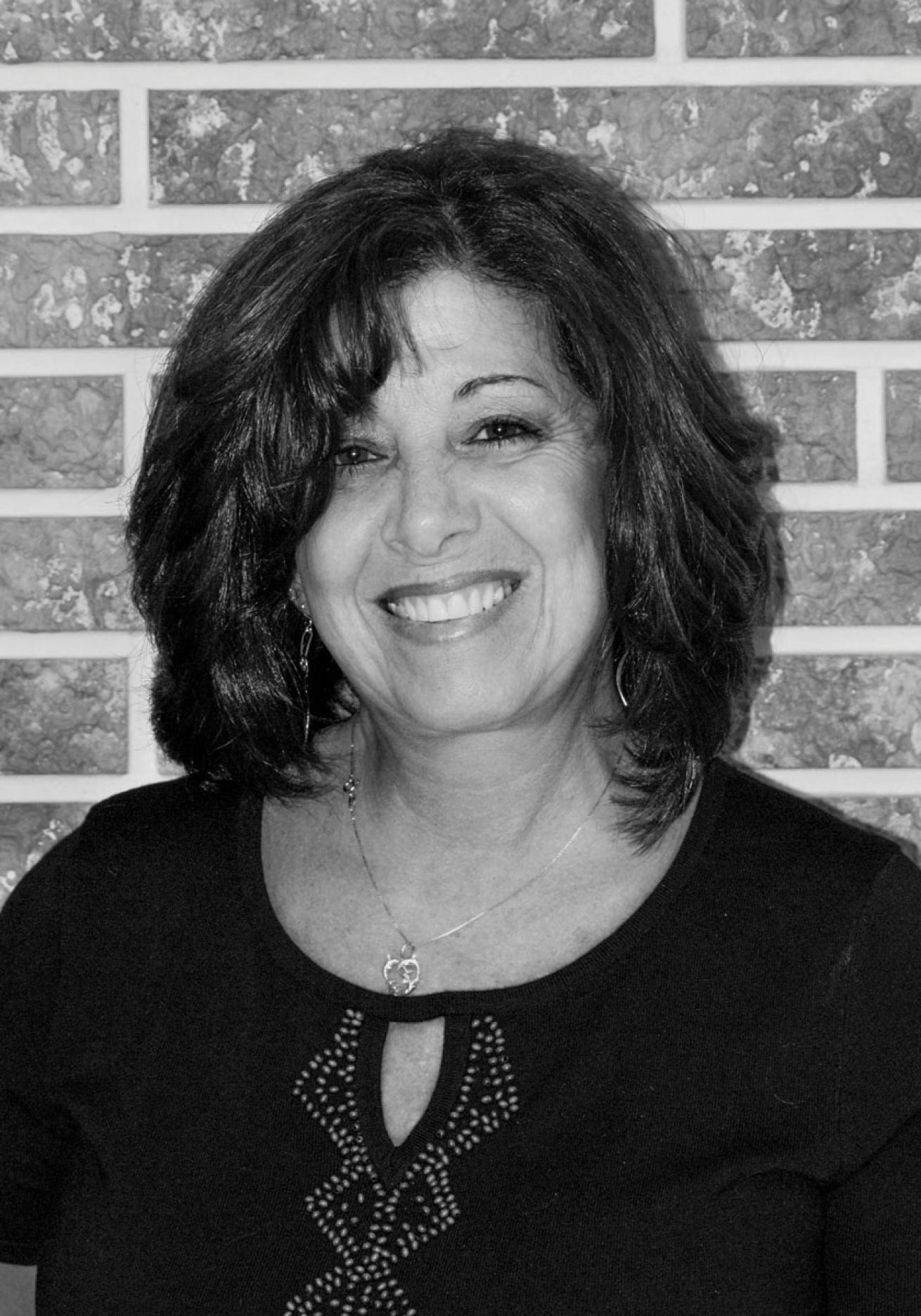
Courtesy Suzan MeldonianSuzan Meldonian
Any conservationist knows, it takes a village. But sometimes it also takes a town crier, someone to raise consciousness, or an alarm, when a precious place needs help. Author and underwater photographer Suzan Meldonian has worked for years—and authored two books on the subject—to raise awareness of Florida’s treasured Blue Heron Bridge, books cited by government officials as helping to open the eyes of nondivers to the economic value of the bridge as a tourist destination, leading to the establishment of a snorkel trail to reduce pressure on the bridge’s unique environment and laying a foundation for state protections that are still evolving and expanding today. For her persistence, vision and drive to share her belief that all creatures are connected on Planet Earth, Meldonian is our April Sea Hero.
Q: You were one of a passionate group of divers who worked hard over many years to preserve Florida’s Blue Heron Bridge for future generations, and your books Under the Bridge and the BHB Companion have been cited by public officials as well as divers as instrumental in that fight. Can you tell readers a little bit about why BHB is so special?
A: Blue Heron Bridge is a unique tidal nursery/muck dive. The beauty of it is, you never know what you’ll see at the BHB! Manatees, mantas, fish with feet like hairy frogfish, sea robins, seahorses—even schools of cownose rays have graced the BHB. Every month there is a different migration to be observed—you just have to become macro-aware. You could spend your entire life diving and never see half the creatures that we find at the bridge. While it isn’t a lush tropical reef, it is a great place to study marine biology, or practice your underwater photography. Because diving here is tide-dependent, this refreshes the seascape with each tidal exchange.
Q: You have a statement on your web site that we loved: “Ocean life has feelings, families, rules and society structures.” How have you seen this circle of life play out at Blue Heron Bridge in particular?
A: I recall becoming fascinated with a small school of bluelip parrotfish juveniles playing a game of tag with a piece of crystalized tube worm stem, much like you may have seen dolphins with a piece of seaweed playing capture the flag. If you stay put and just watch a specific spot, you may also soon come to realize that many juvenile fish have “cleaner fish duty,” sort of a rite of passage in their life cycle. I have often wondered if they must do this to develop respect for their elders and other species, or if it is to form alliances for their life as adults. Likewise, you may observe large fish guarding younger fish, regardless of species—it’s quite endearing. As for feelings, one of the most amazing moments for me was being close by the wall; up top, a little boy was lowering a rusty old hook to see if he could catch a fish just as I was trying to photograph a seaweed blenny. It saw the hook before I did, and it cringed as the hook lowered into sight. I was amazed at what I had witnessed; the blenny seemed to recognize the hook and bristle fearfully at what it represented. Another amazing moment was on one of the worst-viz days; I found my way to a yellowhead jawfish to see if it had eggs. There were no other divers around, but there was a very pesky barracuda poking its nose into the sand and threatening the jawfish’s domicile. I hunkered down, trying to determine whether or not he had eggs. The proud daddy popped out of his escape hole close to me and, much to my surprise, presented his eggs to me. It was as if he wanted me to know he needed help defending his den and realized I was friend, not foe. When I waved the barracuda away, the jawfish stayed right next to my port, allowing me to get an incredible shot—almost a thank you for the ring of protection.
e.
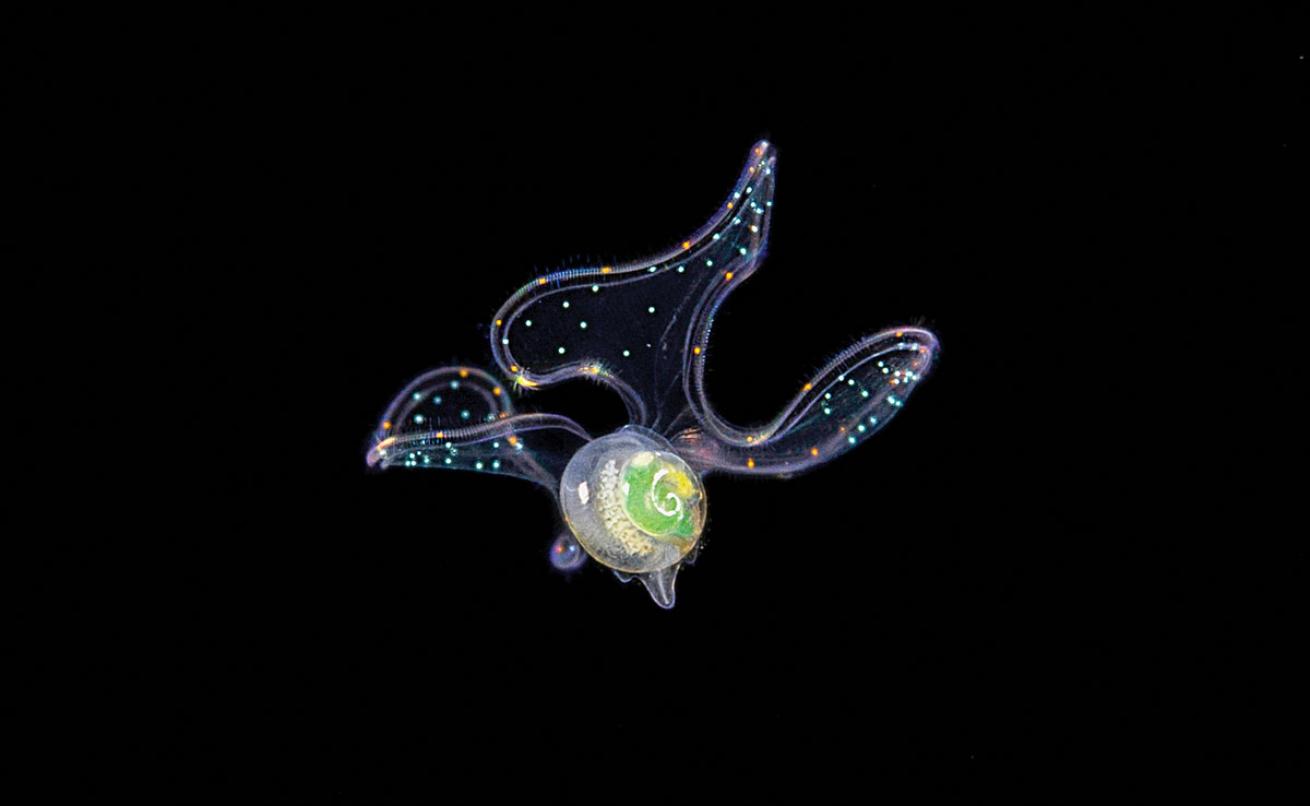
Suzan MeldonianA larval sail, seen on a Gulf-stream black-water dive.
Q: You have been focused of late on blackwater diving, which is spreading around the globe including on Florida’s east coast where you are based; how does your approach to photographing this unique environment play into your mission to spread global change and what you have called “evolutionary education”?
A: The black-water realm is truly the beginning of life in the oceans, which in turn supports all life on land. It’s about documenting planktonic creatures of the “vertical migration”—the largest migration on Earth, which occurs underwater every night around the globe. Through my imagery and stories, my mission is to motivate global change and encourage others to do the same. By introducing children and families to the unimaginable and never-before-seen creatures that exist beneath the horizon, I hope to inspire a visual experience that spurs curiosity and cultivates a thirst for knowledge. Knowledge is power. Hence photographers’ images become what I call “evolutionary education.” I say to the planet, “Evolve with us.” As photographers learn more and share, so do you. Inspiration plants the seeds of discovery, especially about the health of our planet.
We share the planet with this water world that covers 72 percent of Earth, and produces 50 percent of the oxygen. As we evolve our global intellect, shouldn’t we all clearly understand what impact ocean acidification has on the tiniest of creatures at the beginning of the food chain? More importantly, what control do we have in reducing that impact? The air we breathe depends on it.
What harm can carbon emissions do to our little friends? In short, plankton consumes carbon dioxide and, together with sunlight, photosynthesizes, creating its bi-product, oxygen. When there are abnormally high levels of carbon emissions in the ocean from runoff from cities—such as from the oil from your car—the additional carbon is absorbed into the shells of plankton and phytoplankton. This disrupts their ability to grow properly. The thinning of their shells lowers their ability to produce oxygen at the same levels as they have for millions of years. They are also the main food source for smaller animals that are eaten by larger animals, and so on up the food chain.
Besides the fact that the black-water realm is just chock-full of some of the coolest creatures we’ve ever seen, it has opened an entirely new substrate of underwater photography. Scientists have joined our mission through Facebook pages and are having a field day with data we are providing, just from our photos—how cool is this? We are overcoming barriers to underwater discovery through photography, joining citizens, scientists and photographers to bridge the gaps and unilaterally evolve the understanding of our world underwater to protect our natural resources.
Q: Underwater photographers have a unique ability to spread the word of ocean conservation much farther and more quickly than the average diver — what advice would you give to budding underwater shooters about making that mission their own? And how to succeed in spreading the word?
A: Follow your passion, and allow your passion to develop. Take every opportunity to learn how to take more captivating images; learn the ins and outs of your camera’s capabilities; and learn the science that goes with the subject. Look at your own images, and study the masters. Take images of typical subjects in an unusual way, and try your hand at writing an article or two. Introduce your friends, family and school to the underwater realm through presentations, then network it. Social media is a great way to forge new friendships, dive with masters and receive immediate feedback on your impact. Join a nonprofit group to learn more—your images can help them make a difference.
Q: What do you view as the greatest challenges in marine conservation today? How are these challenges reflected in your own work?
A: Money, profits, taking more than is needed, wasting, killing for traditions, the politics of keeping businesses happy even at the expense of unnecessary overfishing waste. I’ve seen a huge decline in the volume of visible fish. I’ve been night diving in remote locations when fishing nets and dredges were dropped on top of us, entangling us, then scooping up everything from the sea bed. I’ve been in remote locations where blast fishing or dynamite fishing, as it is called—a practice of using explosives to stun or kill schools of fish for easy collection—was in use, nearly deafening us permanently. It’s a very sensitive subject as locals need to feed their population somehow. But it’s clear that more education is needed on ocean sustainability on a global basis. With my involvement with Florida’s Palm Beach County here at the BHB, we found one solution by installing an artificial reef that attracts fish, which improves fish counts and thus increases the location’s tourism appeal to not only divers and underwater photographers, but snorkelers and families as well. I am certain that conservation can be influenced by photographers and scientists in cooperation with local government in any given area.
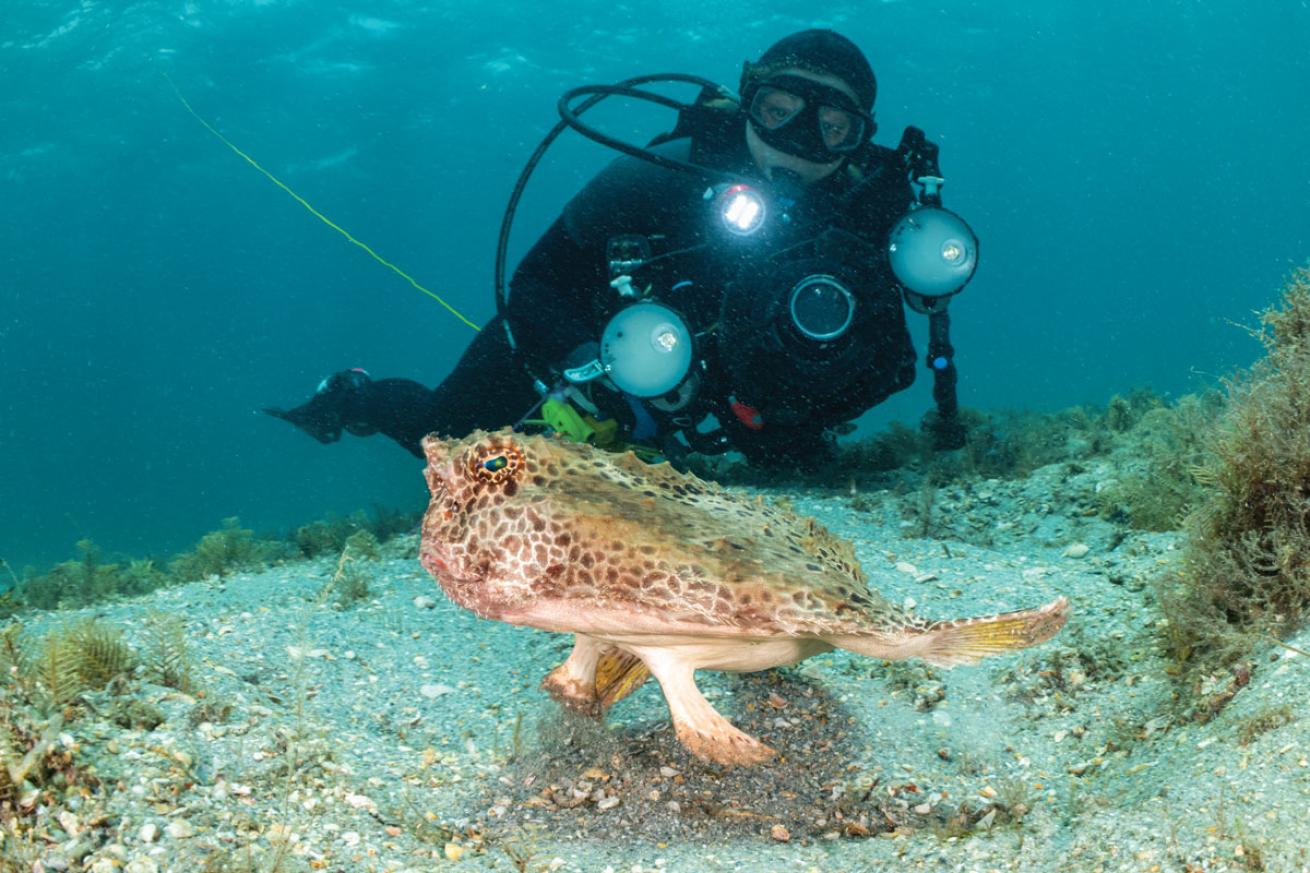
Fan ZhangMeldonian observes a batfish at Blue Heron Bridge in Riviera Beach, Florida.
Q: What's been your most satisfying moment?
A: Being present for the opening of the snorkel trail at Blue Heron Bridge, and seeing my hopes and dreams carried on by the community, the day they made it a no-take zone. Second, being invited by the Indonesian Board of Tourism to be part of a team to photograph untouched reefs to promote underwater photography for the sake of tourism as an alternative means of income vs. fishing. During our trip, we met with government officials in each region to answer their questions and relay our concerns about fishing methods, and help them to promote these locations through tourism books produced with our images. The looks on their faces as they reviewed our beautiful images, instilling in them a sense of pride in their natural resources, really made me happy. Even though they live on islands, very few had actually ever been underwater. They evolved.
Q: What's been your most surprising moment?
A: Being selected as one of Scuba Diving magazine's annual Sea Heroes. I am totally humbled and honored. I am just one of so many worthy people. Also, my first “jump” to free dive with a blue whale. As I beat my legs to catch up with this 65-foot behemoth, it shifted towards me and slowed to observe me, face to face, for about 15 seconds. I could have touched its nose. We connected for that one long moment. I was so taken by the encounter that I forgot to take a picture! I just love it when you have that one-on-one connection with marine wildlife, a moment of curiosity and mutual respect. That grabs my heart every time.
Q: Who are your "sea heroes"?
A: Michael Patrick O’Neill, who spreads the word to thousands of children every year as a speaker and national author of children’s books about sea life. Alex Mustard, whose imagery and kindness in sharing his knowledge has always blown me away. Tim Ho, who has helped thousands of people learn to take underwater photography in an inexpensive way. Jerome Kim, whose imagery always jump-starts my creative juices. Michael Aw, who has inspired so many and worked so feverishly to educate the world about sharks, and inspired my research into black-water photography. David Doubilet, a household name second only to Jacques Cousteau. Lee and Phil Burghard, with their amazing underwater videos, who freely share their knowledge and are teaching the next generations. Jill Heinerth! And all the people here who worked so diligently to get BHB finally deemed a no-take zone. My hat is off to them!
Q: Is there anything we did not ask that you would like readers to know? A: Our planet has grown, but the ocean has not. As we have learned from the Blue Heron Bridge environment, it’s all about balance and sustainability. My work there was just the beginning. More importantly, I support and encourage others to step forward and carry the torch of reason within our community. When they do, they become my heroes because they listened and they evolved. It takes a community.

